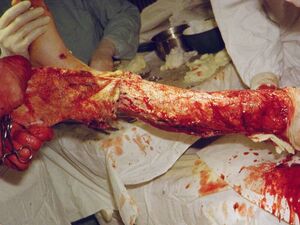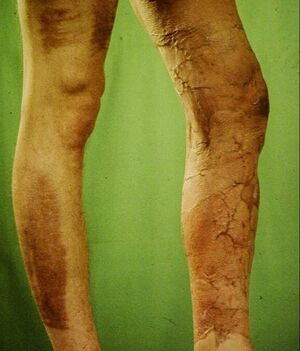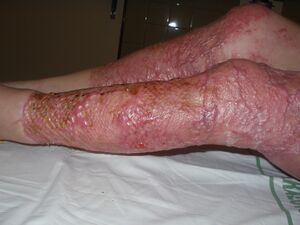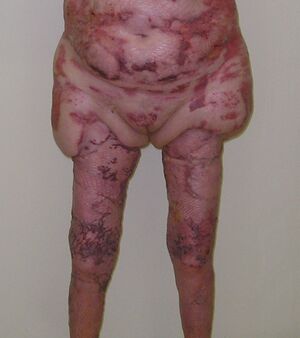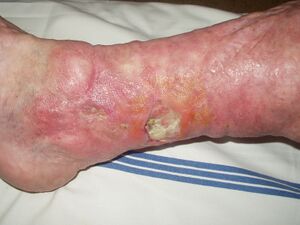Fascial excision
Fascial excision (or avulsion) removes devitalized tissue in its entirety, skin, subcutaneous tissue and fat up to the fascia (sometimes including the muscle fascia). It is indicated in very deep burns (charring, contact burns with long exposure, electrotrauma) and in very extensive, life-threatening lesions with full-thickness skin loss. It is performed either as sharp dissection or blunt avulsion.
Execution
It is advantageous to combine both methods, i.e. sharp dissection using a surgical scalpel and large, blunt preparatory scissors alternating with blunt avulsion, depending on the course of the operation. The blunt avulsion is always performed manually using threaded gloves, threaded over rubber gloves to allow a good grip on the tissues. The fingers dissect away the necrotic skin and subcutaneous tissue at a level just above the fascia. Here, bleeding is minimal, only from perforating vessels that can be easily captured. Major bleeding must be countered only in the transition zone to the healthy area, where a steep transition between the healthy and the unnecrotic area occurs and is later evident in the assessment of permanent consequences.
Advantages
- operating time is shorter, which is contrary to some foreign data.
- blood loss is significantly smaller compared to tangential excision of more superficial burns;
- the bed (fundus) after fascial excision is usually safe and healthy and suitable for early autotransplantation
Disadvantages
- The length of the operating time depends, of course, on the experience, skill and cooperation of the operating team.
- The cosmetic deformities that occur during fascial excision at the transition to healthy tissue appear as a strikingly steep transition, especially in obese patients. If part of the subcutaneous adipose tissue is preserved, they sometimes, in our experience, almost flatten out within two years or even later, but sometimes they remain as a permanent consequence (see attached figures).
- The distal edema produced by circular excisions depends on the individual disposition of the patient, the rehabilitation system and the patient's compliance with it. Compared with foreign reports that indicate a high incidence of edema, this complication is less common in our practice. It occurs more frequently in the lower limbs.
- The damage to superficial nerves and tendons during fascial excision and associated skin denervation may or may not be reversible;
- The avascular fascia over joints (elbow, knee, ankles) does not provide adequate nutrition to the graft and may cause graft loss. In these locations, it is then necessary to wait for the growth of granulation to make the transplantation successful. However, the condition may require repeated surgical interventions down the line.
Coverage of these problem areas may be an indication for the use of flap plastics, which, however, have certain limitations in burn trauma: firstly, there is usually a lack of healthy areas in extensive burn trauma and secondly, the systemic complications experienced contraindicate the many hours of general anaesthesia required to transfer loose flaps by microsurgical technique. Therefore, conventional two- or single-stalk cylindrical flaps are more appropriate in severe burns. Although they have the disadvantage of a multistage solution, some stages of transfer can be performed under local anaesthesia and thus without overall patient endangerment.
Links
Related articles
Source
- KÖNIGOVÁ, Radana – BLÁHA, Josef. Komplexní léčba popáleninového traumatu. 1. edition. Karolinum, 2010. ISBN 978-80-246-1670-4.

